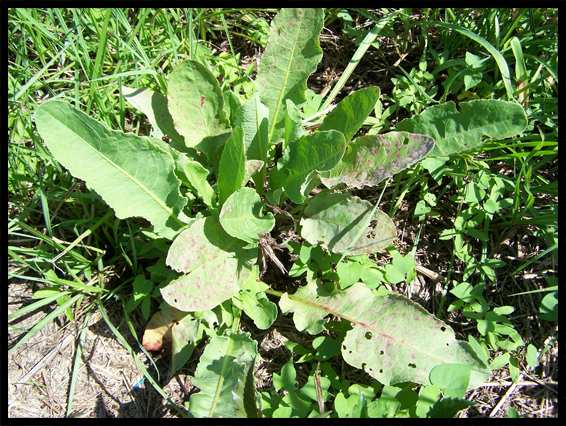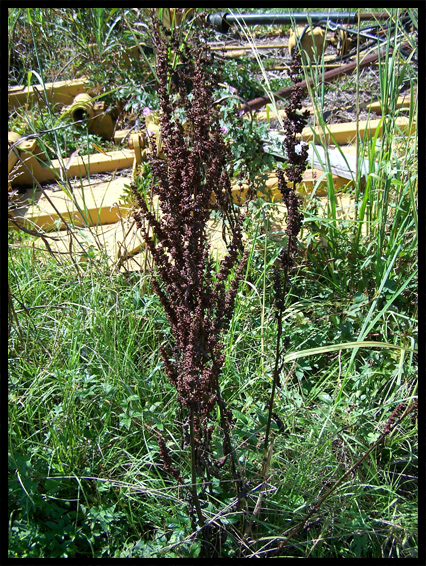Rumex Crispus
Yellow Dock
DESCRIPTION AND EXPERIENCES: Yellow dock is one of those most common looking weeds which almost everyone has in their yard. If not in the yard then it will probably be close by in the ditch. It loves to grow in rich disturbed soil in the garden. There are several species including the sheep sorrel (Rumex acetosella). Sheep sorrel is quite a bit different from the Crispus and rudra, as it really doesn’t have the root system of the others. The tops of the sheep sorrel are the most used in that particular plant whereas the root is the part used in yellow dock. The leaves of yellow dock are lanceolate, acute, strongly undulated, and crisped at the edges, of a light-green color; radical ones on long petioles, truncate, or subcordate at base; uppermost narrower , and nearly sessile. They are easy to recognize in the fall because they will develop a red marking that is due to the effect of the cold weather or so it appears. In the late fall the flowering stems come up and are green and the flowers look more like seeds and quickly make the transition. Then, they quickly turn brown, and the plant becomes quite obvious in a mass because of its brown seed heads standing above the surrounding grasses. This is the best time of year to harvest after the seed heads have turned brown. The roots are spindle shaped and sometimes are about 2 or three inches thick at the top and branch very quickly sometimes into several roots which is how the plants multiples also. The root is very yellow inside to fracture and this is why they call it yellow dock.
Yellow dock is famous because of its ability to increase the amount of iron that is accessible to the blood system. It is also noted because of its ability to purify the blood. In Eclectic medicine it was much used in this way in many skin disorders. It is an excellent agent to cleanse the lymphatic system. Therefore the main uses are when the body is run down and has lost its ability to properly remove toxins.
In anemia yellow dock is one of the most important herbs in the entire materia medica. I have combined it with Polymnia Uvedalia (Bearsfoot), and Poke root. This unique combination would be very fruitful for all those who are in need of a combination to build blood. I have seen the clinical results in cases of chemotherapy and radiation in cancer treatment. Of course these practices kill blood cells and anemia is the immediate side effect. In cases where people have taken this combination the blood count is up the next day.
In my personal experience yellow dock was one of the first preparations which totally convinced me of the efficacy of herbs. I am a vegetarian and in my early days I was quite addicted to sweets. As a result of eating too many sweets and neglecting my diet I developed anemia at least to some degree. I went to give blood for a very dear friend who was in a accident and the technicians wouldn’t take my blood because my blood count was to low. I wasn’t too much concerned about it then, but later as I was working 18 hour days I became very fatigued and at the end of the days I was feeling like I had some chronic disease. I was making only a few tinctures at the time and one of them was yellow dock. I began to take it very regularly throughout the day and very soon I began to feel normal again and became quite impressed with the ability of yellow dock in this regard.
Yellow dock is very much like burdock in its application to skin disorders. Burdock is more associated with the kidneys while Yellow dock is more associated with the liver and actually can be used to strengthen the function of the liver as well as help to eliminate the toxins associated with under activity due to accumulation of toxins. It is also associated with the liver in regards to overcoming anemia in that it increases the liver’s ability to store iron. Thus yellow dock is definitely closely associated with liver function. Of course, the connection with liver and skin disorders is also understood, thus this as well as cleansing via the lymphatic system could help us understand how yellow dock is so effective in skin disorders. These include eczema, impetigo, etc. Yellow dock is also noted for yeast infections which was called nursing sore mouth in Eclectic medicine. It appears in this connection to be able to purify the system in such a way as to not allow the impurities to cause the proliferation of undesirable bacteria, etc.
In Eclectic medicine Yellow dock was used in respiratory conditions where there was a wasting condition such as in TB. It can also be used in coughs in general, although it will be most useful in conditions where the body is run down.
Yellow dock is very safe and the dosage can be quite large in order to rebuild the system. During pregnancy it is very useful to give strength and tone to the whole system and for women in general it helps to rebuild the system from excessive menses.
The dosage should be 30 to 60 drops frequently repeated to achieve the full result in anemic conditions.
I have used the root to make a salve with excellent results. One way to make a very strong preparation is to take a quantity of root to fill a crock pot and cover it with olive oil. Put this on the low heat and leave for 12 hours and then strain. Then put more root in the same oil again until you have used three batches of root. This causes the oil to be a very strong representative of yellow dock. It can be used in any type of itch. You can also add other astringents and soothing agents such as oak bark or comfrey root to this for various purposes, but yellow dock can be used alone. I usually add poke leaves with the root in order to help with eczema, etc. Enough beeswax is added to make the oil a salve consistency.

